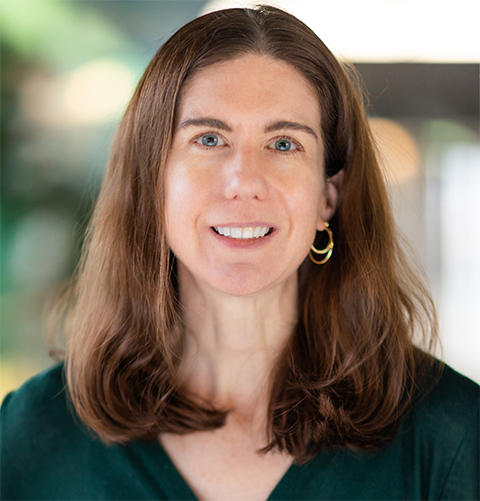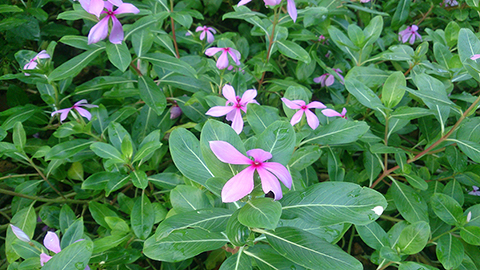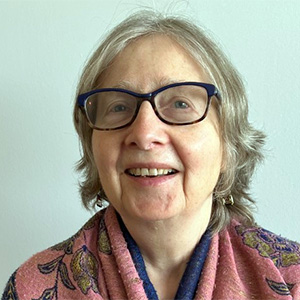Meet Sarah O’Connor
Sarah O’Connor was a postdoctoral fellow in an enzymology lab when she realized that most of the biochemists in her area were studying microbes and few were studying the complicated genomes of plants — so she decided to make plants her focus. She is now the director of the department of natural product biosynthesis at the Max Planck Institute of Chemical Ecology in Jena, Germany.
After receiving a bachelor’s degree in chemistry at the University of Chicago, O’Connor earned a Ph.D. in organic chemistry at the Massachusetts Institute of Technology. Her postdoctoral research in biochemistry took her to Harvard Medical School, where, in the laboratory of the late Christopher T. Walsh, she discovered her research path.

O’Connor returned to MIT as an assistant and then associate professor of chemistry. She crossed the Atlantic to the John Innes Centre, an institution for the study of plant and microbial science in Norwich, U.K., where she quickly rose from lecturer to professor and then honorary professor. A call from a friend led her in 2019 to her current position.
O’Connor’s science has won her multiple awards. Most recently, she took home the 2023 Gottfried Wilhelm Leibniz Prize for fundamental discoveries in plant natural product biosynthesis. In 2022, she received the Ernest Guenther Award in the Chemistry of Natural Products from the American Chemical Society. In 2019, she garnered the Perkin Prize for Organic Chemistry from the Royal Society of Chemistry for the discovery, enzymology and engineering of the biosynthetic pathways for complex natural products from plants.
In 2022, O’Connor began serving as an associate editor for the Journal of Biological Chemistry. This conversation has been edited.
How did you come to venture into plant biochemistry?
When I was doing my postdoc with Chris Walsh, he was working on antibiotic synthesis, studying how microbes made complicated molecules. As I was reading the literature, I realized immediately that far fewer people were working in the area of plants. The genomes are more complicated; the biology is more complicated. I thought, “Let's keep the fundamental idea of being able to understand how nature does complicated chemistry but look and see how plants do it as opposed to bacteria or other microbes.”
Bacteria are very good at organizing metabolic pathways into the segments of DNA we call operons. One stretch of the genome may have 10 genes all dedicated to the same pathway. In bacteria and even fungi, you can use a technique called genome mining to get a genome sequence, and then you can put those genome sequences into this beautiful software, and search the bacteria for so-called “gene clusters.” Then you can identify the gene clusters very easily.
In plants, it's more complicated. Plants have much bigger genomes, so identifying individual genes is more difficult in a plant than for bacteria. Genes don't tend to be organized in operons, as they are in bacteria. Occasionally, they're proximal to each other, but there's a lot of distance between them, and sometimes they're just scattered randomly all over different chromosomes.
We know comparatively little about the noncoding regions of plant genomes. Now, with all the next-generation sequencing technology, we can start to look at chromatin structure and DNA structure. By better understanding the three-dimensional structure of the DNA, we can get a better idea about how these genes at distant points in the genome might actually be interacting with each other.
So does genetic research on plants require special techniques?
One of the great things about working with plants is that all the people who are working on cancer and human biology pioneer wonderful techniques, and then we can turn around and try to apply them to plants. A lot of these techniques were pioneered in mammalian cell systems. One of these was single-cell sequencing. In the last couple of years, it has just been made feasible for plant systems.
When you're looking at these very complicated metabolites, they're typically only being produced in a very small subset of the different types of cells that you see, for example, in a plant leaf. A plant leaf has dozens of different cell types, and maybe just a couple of those cell types are producing a complicated molecule.
When you’re trying to identify 10, 20 or 30 genes out of a plant that is expressing 40,000 or 50,000 genes, single-cell resolution, transcriptomic data make much more highly resolved data sets. It's fascinating because those leaves are also going to have pigment materials and structural materials to hold them together.
What’s involved in your study of medicinal plants?
It’s difficult to get new drugs or new treatments into common use. A lot of regulatory hurdles need to be overcome. We focus on proof of concept: studies that show what can be possible.
The idea is to make analogs of plant compounds. We’re getting closer and closer to coming up with things that are useful, using biosynthetic genes and production platforms. We can then collaborate with people who do more rigorous biological or pharmacological testing.
In medicinal chemistry, it’s been shown over and over again that if you can do these structure-activity relationship studies, you can make very small changes around the structure of the molecule and then test those analogs. Tiny changes in the chemical structure of the molecule will have a big impact on its biological activity or its therapeutic value.
From a medicinal chemistry standpoint, putting atoms like fluorine or chlorine on the structure of a drug can change the pharmacokinetics of the compound. Medicinal chemists have found this often produces interesting changes in the biological activity of the compound.
You recently coauthored a study of the medicinal plant, Catharanthus roseus (Madagascar periwinkle), with a team from the University of Georgia. How did you all connect and what are you trying to learn?
I collaborate with Robin Buell at the University of Georgia. We first got to know each other in 2009. We applied to the National Institutes of Health to study Catharanthus. We convinced the NIH that they should fund a large-scale plant transcriptomics initiative. This was the first federally funded medicinal plant omics initiative in the United States.

I was the biochemist in the consortium; Robin was the sequencing and genomics person. Everything that I know about genomics and transcriptomics, Robin taught me.
We've continued the collaboration since then, and it was Robin who, a couple of years ago, said to me, “Sarah, we need to be thinking about single-cell transcriptomics.” And the paper you were referring to came out of that.
That was just a starting point. We have a number of other plants in the pipeline that we're looking at. The people in her lab are really trying to understand how the plant controls the production of some of these compounds.
In our lab, we're interested in using these data sets to find new biosynthetic pathways. And we're also interested in seeing how these data can help us engineer better production of these compounds using synthetic biology and metabolic engineering strategies.
How did you get connected with the Journal of Biological Chemistry? What are your criteria for reviewing a paper?
If I have a nice piece of biochemistry, JBC is just the journal to send it to. I think this journal is an important place for research.
If we publish, we have to contribute to making the journals work, so being an associate editor is a service that I’m happy to do. It’s also a good way to learn new things. Even by just skimming the abstract of a paper sent to me to handle, I usually learn something new.
First and foremost, the manuscript must contain a new biochemical discovery, such as the discovery of a new enzyme, a new mechanism or revision of an old mechanism. The data are held to the highest standard. Finally, presentation is important. Figures should be clear, and the manuscript must be well written.
What’s your advice for younger women in biochemistry?
I think all of us who are being honest and humble, including me, would say our careers are a work in progress. You're still learning at every phase of your career.There's definitely advice I give younger female scientists: Women scientists need to sell themselves better. I've been on review panels that require an interview. There is a trend for younger female scientists to be more self-deprecating or less forthcoming than men about their big scientific vision. I don't think it's because they don't have one; it's because they're reluctant to express it. I really encourage women scientists to express their scientific thoughts in a confident and logical, but not arrogant, way.
What’s the next research frontier you're interested in exploring?
It's amazing how a new environment prompts you to look at new systems. I now work at an institute with a lot of entomologists. We recently published a paper on aphids, and it turns out that aphids make the same molecule that the catnip plant does. It’s called nepetalactone.
Female aphids produce it in their legs and use it to attract male aphids with sexual hormones. We were able to find the biosynthetic pathways in both the catnip plant and the female aphid hind leg and compare them. We couldn't have done it without the help of entomologists here.
Nepetalactone is not a pharmaceutical, but it has a lot of promise as an insect repellent.
What do you do to recharge after a long week in the lab?
I like to go hiking anywhere from 10 to 30 km, depending on the kind of week I’ve had. During the summer here, it’s really nice to get out in the sun. Jena is in the former East Germany, in a mountainous region, so there's a lot of beautiful scenery around.
Of course, I pay attention to the plants and try to pick out the ones I recognize. Given my colleagues here, I’m starting to pay more attention to the insects I see as well.

Enjoy reading ASBMB Today?
Become a member to receive the print edition four times a year and the digital edition monthly.
Learn moreGet the latest from ASBMB Today
Enter your email address, and we’ll send you a weekly email with recent articles, interviews and more.
Latest in People
People highlights or most popular articles

ASBMB names 2026 fellows
The American Society for Biochemistry and Molecular Biology announced that it has named 16 members as 2026 fellows of the society.

ASBMB members receive ASM awards
Jennifer Doudna, Michael Ibba and Kim Orth were recognized by the American Society for Microbiology for their achievements in leadership, education and research.

Mining microbes for rare earth solutions
Joseph Cotruvo, Jr., will receive the ASBMB Mildred Cohn Young Investigator Award at the ASBMB Annual Meeting, March 7–10, just outside of Washington, D.C.

McKnight wins Lasker Award
He was honored at a gala in September and received a $250,000 honorarium.

Building a stronger future for research funding
Hear from Eric Gascho of the Coalition for Health Funding about federal public health investments, the value of collaboration and how scientists can help shape the future of research funding.

Fueling healthier aging, connecting metabolism stress and time
Biochemist Melanie McReynolds investigates how metabolism and stress shape the aging process. Her research on NAD+, a molecule central to cellular energy, reveals how maintaining its balance could promote healthier, longer lives.

